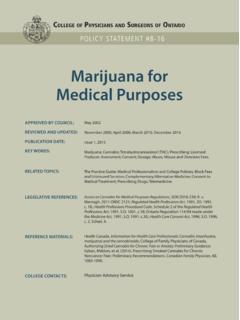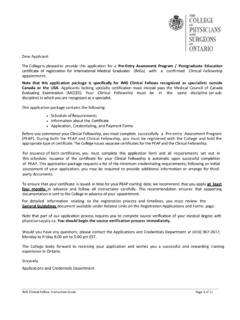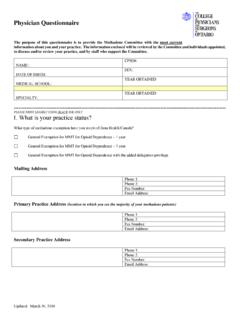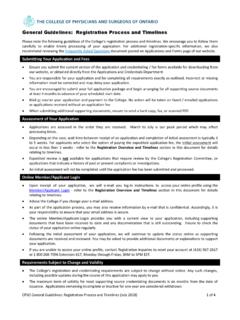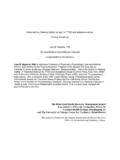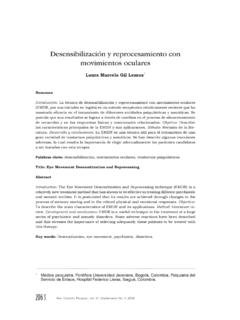Transcription of ASSESSMENT REPORT EXAMPLE - CPSO
1 ASSESSMENT REPORT EXAMPLE SAMPLE TREATMENT DISCHARGE SUMMARY FROM PROFESSIONAL RENEWAL CENTER (PRC), KANSAS This treatment discharge summary is a sample work product of the Professional Renewal Center. All identifying information has either been omitted or disguised for purposes of confidentiality. March 14, 2003 William Reynolds, MD United States Physicians Health Program 123 Sunset Way, Suite 100 Anytown, USA 45678 RE: Ian Frank, MD Dear Dr. Reynolds: I am writing in regard to Ian Frank, MD, a 29-year-old third year surgical resident who recently completed a multidisciplinary ASSESSMENT and treatment process at the Professional Renewal Center (PRC) in Lawrence, Kansas.
2 Dr. Frank came to PRC for a multidisciplinary ASSESSMENT on January 27, 2003, and then transitioned into our intensive day treatment program for professionals on February 3, 2003. He was discharged on March 14, 2003. The members of Dr. Frank s ASSESSMENT and treatment team included Bruce Parsa, DO, board certified psychiatrist; Loree Cordova, MD; family medicine physician; Scott C. Stacy, PsyD, licensed clinical psychologist; Mary Yanics, PhD, licensed clinical psychologist; George Athey, PhD, consulting psychologist; Sue Porter, MSW, LSCSW, licensed specialist clinical social worker; Jeffery Lewis, LSCSW, BCIAC, licensed specialist clinical social worker; Scott Campbell, CARN, RN, BC, certified psychiatric and addictions nurse; and Peter Graham, PhD, director of the team and consulting psychologist.
3 The members of Dr. Frank s ASSESSMENT team formulated diagnostic conclusions and recommendations for his care through a process leading to consensus. Waiver of Confidentiality Dr. Frank has provided us with written authorization that permits us to disclose to you the results of his treatment. This summary was prepared with Dr. Frank s full knowledge and informed consent and integrates information gathered over the course of his treatment. This information includes: 1) clinical interviews; 2) results of psychological testing; 3) disclosures made by the patient during interviews and on self-evaluation questionnaires and written assignments; and 4) information obtained from collateral sources including other professional evaluations.
4 Dr. Frank was informed of the treatment team's duty to REPORT certain information, if obtained, in accordance with state and national laws. Further disclosure of this REPORT and any other medical information is not permitted under the terms of this authorization without Dr. Frank s expressed written consent. Caution in the Use of this REPORT The conclusions of this treatment process were derived from the information provided by the patient and collateral sources. We have not attempted to ensure the accuracy of all collateral information obtained or provided. Dr. Frank was given the opportunity to provide any collateral information felt to be relevant and helpful in order for our team to conduct an objective ASSESSMENT .
5 Concerned parties, and in particular the referring party, were provided with the same opportunity. The diagnostic conclusions, opinions and recommendations contained herein are based upon this data, and are stated with a reasonable degree of medical certainty unless otherwise indicated. Additional information not disclosed to us by Dr. Frank or provided by collateral sources could alter the findings outlined in this REPORT . The team reserves the right to amend its opinions and conclusions in such situations. Natural limitations in the treatment process and our state of knowledge are acknowledged. Therefore, we cannot fully and accurately predict Dr.
6 Frank s future behaviors or actions. Collateral Information Reviewed: 1. Referral information provided via telephone from William Reynolds, MD, of the United States Physicians Health Program 2. Detailed timeline of events during internship and residency, summary description of employment situation, and personal inventory of problems written by Ian Frank, MD 3. Adverse Action Recommendation letter dated November 13, 2002, from Dr. O Reilly, Director, Surgery Residency Training Program, Dr. Lester, Interim Chair, and Dr. Rosenblitt, Director, Graduate Medical Education, of the State University Department of Medicine to Dr. Frank 4. Cover letter dated November 18, 2002, from Dr.
7 Rosenblitt to Dr. Frank 5. Letter dated November 26, 2002, from Robert Stone, MD, Dr. Frank s personal psychotherapist, to Dr. O Reilly 6. Dismissal letter dated December 2, 2002, from Dr. O Reilly to Dr. Frank 7. Letter of reference in support of Dr. Frank, undated, from Michael Johnstone, MD, presumably sent to Dr. O Reilly 8. Letter of reference in support of Dr. Frank, dated December 18, 2002, from Emily Campbell, MD, presumably sent to Dr. O Reilly 9. Letter of reference in support of Dr. Frank, dated December 18, 2002, from thirty members of the State University Medical Center Surgery Residency class to the Hearing Panel of the Office of Graduate Medical Education, State University Medical Center 10.
8 Letter outlining the decisions and recommendations of the Hearing Panel of the Office of Graduate Medical Education, State University Medical Center, dated December 20, 2002, from the members of the Hearing Panel to Dr. Frank 11. Letter requesting a meeting with Dr. Frank, dated December 23, 2002, from Dr. O Reilly to Dr. Frank 12. Routine Corrective Action Plan for Ian Frank, MD, dated January 8, 2003, as signed by Margaret O Reilly, Director, Surgery Residency Training Program, Harvey Lester, MD, Interim Chair, and Ian Frank, MD 1. Letter dated January 23, 2003, from Dr. Frank to Dr. O Reilly and Dr. Lester 13. Phone and face-to-face interviews with Dr.
9 Frank s wife 14. Phone interview with Dr. Frank s mother 15. Phone interview with Dr. Robert Stone Summary of Treatment: Over the course of seven weeks, Dr. Frank participated in various forms of ASSESSMENT and treatment to explore and resolve his difficulty with disruptive behavior and unprofessional conduct with colleagues and peers and aggressive, intimidating behavior toward his wife. These difficulties were addressed within the context of various modes of treatment including: 1) Twice weekly individual treatment coordination and psychotherapy meetings with this writer 2) Psychopharmacological evaluation and medication monitoring under the care of Dr.
10 Parsa 3) Biofeedback and Alpha-theta neurofeedback treatment with psychological processing conducted by Mr. Lewis 4) Eye-movement desensitization and reprocessing (EMDR) therapy, expressive-supportive psychodynamic psychotherapy and couples therapy with Ms. Porter 5) Daily Group psychotherapy 6) Daily Professional Ecology group 7) Daily Roles and Relationships group 8) Daily Studies in Transformation recovery group 9) Daily Integration and Wrap-Up group 10) Individual discharge and relapse prevention planning with Mr. Campbell The ASSESSMENT team recommended that Dr. Frank enter into an intensive treatment program for professionals to address the issues of his disruptive, devaluing behavior and the underlying anxiety and depression with which this behavior was understood to be an attempt to cope.

